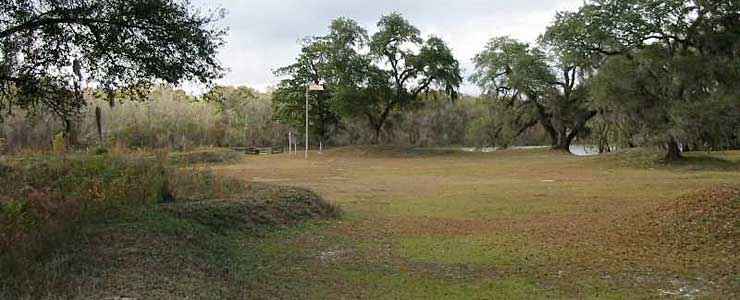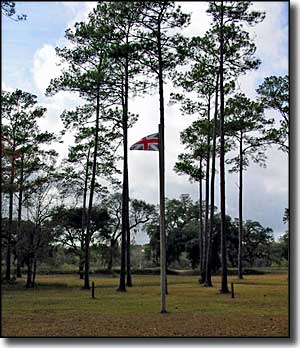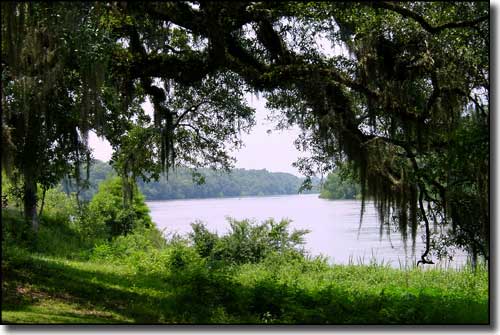Fort Gadsden National Historic Site

Fort Gadsden National Historic Site

Fort Gadsden was the last name in a series of names that graced a couple of forts built along the Apalachicola River in Florida's panhandle, beginning during the War of 1812 and lasting into the Civil War.
The original fort on Prospect Bluff (Prospect Bluff Fort, Nicholls' Fort or the British Post, depending on who you talk to) was built in late 1814 by a group of Royal Marines led by Lieutenant Colonel Edward Nicholls. (Prospect Bluff is about 15 miles north of the mouth of the Apalachicola River in what is now Apalachicola National Forest.) But then the War of 1812 ended and the British troops left. However, when Nicholls left, he left the fort set up with guns, ammunition and a few cannons. When British troops revisited the area, they used the fort as a base for recruiting Seminole and Choctaw Indians to attack US positions to the north. The fort was also a place that ex-slaves escaped to and joined the Corps of Colonial Marines (a British force composed of former slaves who worked in service to the British on the American mainland).
When the final British forces left the area, they handed the fort over to their allies: maybe 30 Seminole and Choctaw Indians and about 300 fugitive slaves. At this point, the fort came to be called the "Negro Fort" and as many as 800 more fugitive slaves came to settle in the surrounding area. As if the presence of the fort wasn't enough to threaten slave-holders in the American territories, at times the folks in the fort led attacks on plantations in Georgia for supplies and to free more slaves. Eventually, that brought down the wrath of the then-fledgling US Army.
Fort Scott was built by the Army on the west bank of the Flint River in Georgia, specifically to guard the Spanish-American boundary (Florida had reverted to the control of the Spanish with the Treaty of Versailles). A problem with Fort Scott, though, was the supply route: by land it was through a long stretch of unsettled wilderness. The fort was easier to supply by running naval vessels up the Apalachicola River. A naval force entered the Apalachicola on July 17, 1816, and headed north, getting fired upon by the residents of the Negro Fort when they came in range. 4 Americans on the boats were killed. A few days later, the military commander of the Southern District, one Major General Andrew Jackson, ordered Brigadier General Edmund P. Gaines at Fort Scott to destroy the Negro Fort.
On July 27, 1816, troops from the 4th U.S. Infantry reinforced with hundreds of allied Creek warriors surrounded the Negro Fort. The occupants of the fort raised the English Jack and a separate, solid red flag (indicating they intended to fight to the death). Cannon fire was exchanged but the former slaves were inexperienced with the cannons and couldn't hit anything of consequence. The Americans, however, fired a red-hot cannonball from one of the supporting gunboats that went straight into the enemy's powder magazine and blew it up. The blast was heard in Pensacola, more than 100 miles away. Only 50 of the Negro Fort's 320 men, women and children inside survived the blast. The American commander reported that the "explosion was awful and the scene horrible beyond description." Indians found within the fort were handed over to the Creeks, who killed them all. The Creeks also shot the leader of the ex-slaves "execution style" and all the other survivors were carried back to Georgia and returned to slavery.
Having been promised all the spoils in the fort for their help in the expedition, the Creeks recovered 500 swords, 400 pistols, 50 carbines, 2,500 muskets and a large amount of lead shot. However, as the Creek gained in power, the Seminoles lost and tension between the two tribes increased. A year later, the First Seminole War broke out in the area.
Lieutenant James Gadsden arrived in 1818 and rebuilt the fort on a nearby site. Jackson named it Fort Gadsden in his honor. Florida came into United States possession in 1821 and the fort was manned off-and-on (especially during the Second Seminole War) until the Civil War. Confederate troops occupied the fort until an outbreak of malaria in July, 1863, forced them to abandon the area. Since then, the fort has pretty much just faded back into the background as nature has taken its course in this subtropical climate... although steamboats plying the river were still using this area as a landing site in the first decades of the 20th century.
The Fort Gadsden National Historic Site was listed as a National Historic Landmark on the National Register of Historic Places in 1972 and is in the care of the National Forest Service.

The Apalachicola River near the site of Fort Gadsden

Related Pages
- Alfred B. Maclay Gardens State Park
- Apalachee Savannahs Scenic Byway
- Apalachicola National Forest
- Bald Point State Park
- Big Bend Scenic Byway
- Bradwell Bay Wilderness
- Camp Helen State Park
- Constitution Convention Museum State Park
- Econfina River State Park
- Edward Ball Wakulla Springs State Park
- Falling Waters State Park
- Florida Caverns State Park
- Fort Gadsden Historic Site
- John Gorrie Museum State Park
- Lake Jackson Mounds State Park
- Lake Talquin State Forest
- Lake Talquin State Park
- Letchworth-Love Mounds Archaeological State Park
- Mud Swamp-New River Wilderness
- Natural Bridge Battlefield State Park
- Ochlocknee River State Park
- Orman House State Park
- Pine Log State Forest